Ice sheets, ice caps and glaciers
About 10% of the earth is covered by glaciers and ice caps, again mainly in polar regions. Ice on land is an important factor in the global climate system, particularly because of its impact on sea level, whereas melting of sea ice has no effect on sea level. Glaciers and ice caps respond to changes in the atmosphere and the sea when the climate changes, and thus also provide clear signs of global climate change. Glaciers, and particularly the large inland ice caps, also contain vital information about the earth’s climate back in time. Almost all the glaciers and ice caps in the Arctic have lost mass over the last century, and in many places, ice mass loss has accelerated in the past decade. Antarctica has lost ice mass for two decades. There, however, the losses are chiefly from a restricted area.
Status og trends
About 10% of the earth’s surface is covered by glaciers, ice caps and ice sheets, mainly in polar regions. About 98% of Antarctica is covered by an ice sheet with an average thickness of at least 2.1 kilometres. This ice holds 90% of the world’s fresh water. The ice sheet on Greenland is the largest in the northern hemisphere and contains about 3 million km3 of ice. More than half of the land in Svalbard is covered by ice: a total of 2100 glaciers large and small can be found there.
Glaciers carry important information about ancient climate and function as climate archives. Ice and air bubbles trapped in ice can be analysed to reveal how air temperature and atmospheric content of greenhouse gases such as CO2 and methane have changed over long time spans. Ice cores from Antarctica can reveal temperatures 800 000 years back into the past. Ice cores from Svalbard can also be used to study climate, but these cores are trickier to interpret because summer melting is greater there than in Antarctica. The Arctic has not been continuously iced-over for as long as Antarctica, so climate archives in the north cover less time. In glaciers at the highest altitudes in Svalbard, where summer melting is smallest, it is possible to take ice cores that go 1000 years back in time.
The Arctic
Sustained changes in the expanse, volume and mass of Arctic glaciers are governed by climate and oceanographic factors that affect mass balance. A glacier’s mass balance is the yearly balance between gain of mass, mainly in the form of snowfall, and loss of mass, attributed mainly to surface melting and runoff, and calving of icebergs.
In the 5th IPCC report, the compilation of existing knowledge shows that nearly all the world’s glaciers are shrinking. Of Arctic regions, Alaska and northern Canada have seen some of the greatest losses of glacier mass over the past decade, but the Norwegian Polar Institute’s long observations series from Svalbard show a similar tendency.
As much as 40% of the mass is lost through calving of glaciers that flow into the ocean, at least in the areas where this has been measured. From large parts of the Arctic, no measurements are available: this knowledge gap must be filled to enable future calculation of how quickly glaciers are losing mass.
A recent study calculated how the ice sheets of Greenland and Antarctica contribute to sea level rise and compared this with contributions from glaciers outside Greenland and Antarctica. Both satellite data and ground-based measurements were used. Between 2003 and 2009, meltwater from the world’s glaciers contributed about one third of the observed rise in sea level (global average). The Greenland and Antarctic ice sheets together contributed the same amount. The last third of the sea level rise is attributed increased volume of seawater (thermal expansion). The glaciers that contribute most to sea level rise are those in the Canadian Arctic, followed glaciers in Alaska and coastal Greenland. The world’s glaciers (inland ice sheets excluded) annually lose an ice mass corresponding to an approximate 0.7 mm increase in sea level.
Several parts of Greenland’s inland ice sheet have lost mass in the past two decades. This loss is spreading to new areas of the massive ice sheet, and accelerating. Surface melting and iceberg calving each cause half the loss, and both melting and calving are increasing.
Prior to 1990, Greenland’s ice sheet was in balance. Total ice mass increased with winter snowfall and decreased with summer melting and iceberg calving, and the net mass balance was essentially nil. Since then, the loss of mass has outstripped accumulation through snowfall. The inflow of fresh water to the oceans surrounding Greenland is already so great that it is increasing global sea level. In the late 1990s the Greenland ice sheet supplied 5% of global sea level rise, but estimates from 2005 show that Greenland now supplies 20%. Average sea level increased by about 0.19 m over the period 1901-2010.
Antarctica
On the other side of the globe there are also changes – Antarctica has lost ice mass over the past two decades. Most of this loss is from the Antarctic Peninsula and the area south of the Amundsen Sea in West Antarctica. The ice shelves around the Antarctic Peninsula are changing: the ice has retreated, become fissured, and large areas have collapsed on both sides of the Peninsula. Over the last 50 years, the total area of the ice shelves has decreased by an estimated 28 000 km2. The ice is now retreating about 6 000 kilometres per decade.
Ice shelves retreat when the ice cracks and the cracks are filled with meltwater. Relatively warm seawater also penetrates in under the shelves. When parts of an ice shelf disappear, the inland glaciers that feed into the shelf increase their flow rate. Collapse of some ice shelves on the Antarctic Peninsula has led to a 300-800% increase in the flow rate of glaciers in the areas where the ice shelves have disappeared.
The area south of the Amundsen Sea is the part of Antarctica where the glaciers of inland ice sheet are retreating fastest. For example, the retreat of the Pine Island glacier has sped up 40% since 1970. Thwaite Glacier and four other glaciers in this sector are thinning at an accelerating rate. The flow rate of Smith Glacier has increased 83% since 1992.
At present, this area is losing 50-137 gigatonnes of ice per year, which is approximately the same amount lost from the entire Greenland ice sheet. This is a significant contribution to global sea level rise.
In East Antarctica, the changes in the inland ice cap are less dramatic, with the greatest changes near the coast. The mass of the inland parts of the ice cap is growing moderately because of increased precipitation. Ice shelves differ: some are thickening slightly, others are thinning substantially. Data from passive microwave instruments suggest increased melting of ice shelves.
Rapid changes in West Antarctica
In the Antarctic sector south of the Amundsen Sea, several measurements show that glaciers are thinning and retreating at an increasing rate. Scientists are discussing whether this is a sign that the entire ice sheet in West Antarctica will collapse, or merely natural variability on a scale that has not previously been observed. Collapse of this area alone could raise global sea level 1.5 metres. Satellite measurements show that the ice sheet in West Antarctica is currently losing 100-200 gigatonnes of mass per year, and that the rate has increased over the past twenty years. This corresponds to a sea level rise of 0.28 to 0.56 millimetres per year. Most of the ice loss occurs in the sector bordering on the Amundsen Sea. Ultimately, these changes in the ice in West Antarctica can probably be attributed to higher air and sea temperatures caused by anthropogenic emissions of greenhouse gases. However, more immediate causes include collapse of retaining ice shelves, which allows glaciers flowing toward the Antarctic Peninsula to increase their flow rate, along with inflow of warm water under the ice shelves that hold back the glaciers of the inland ice sheet in West Antarctica.
Model simulations for the rest of this century give different projections of how much sea level might rise owing to changes in the ice of West Antarctica.
If the ice sheet in West Antarctica were to collapse due to higher air and sea surface temperatures, and if ice shelves were no longer able to hold back the inland glaciers, it would have a major impact on global sea level. The ice in West Antarctica is one of several critical elements that could constitute tipping points: changes would have a significant impact on the global climate system. A 5°C increase in air temperature could raise summer temperatures above freezing in some locations, leading to surface melting on the vast ice shelves surrounding West Antarctica. The threshold for melting from below owing to warmer seawater is probably even lower. In the rest of West Antarctica, a local temperature increase of 8°C in summer will bring the ice to the melting point. The time frame for a tipping point for the ice in West Antarctica is highly uncertain: it may be reached during this millennium, but a worst case scenario suggests a collapse within 300 years. A rapid increase in sea level is more likely to come from West Antarctica than from the Greenland ice sheet.
Future scenarios
Available knowledge suggests that the world’s glaciers will continue to shrink, losing between 15 and 85% of their mass before the end of the century, depending on the representative concentration pathway?. The mass balance of the Greenland ice sheet is expected to continue its negative trend. In Antarctica, the rest of the century may offer a slight increase in the mass of the inland ice sheet because of increased precipitation, but this gain will be outstripped by a simultaneous loss of ice along the coast because of increased calving and melting. Thus the net effect on the inland ice sheet is expected to be negative mass balance in the future.
Processes
In many parts of the Arctic, certain glaciers ”surge”. This means that they advance rapidly for a short time, then move slowly again for long spans of time. When a glacier surges, its flow rate increases quickly to 10 to 100 times its normal speed. As a consequence, the glacier develops crevasses. Surges are cyclic phenomena, repeated every 30 to 500 years. The crevassing associated with surges makes previously traversable routes unsafe or impassable. Tidal glaciers can also surge, leading to increased calving when the glacier begins to retreat after the surge. This increases the number of icebergs and has implications for shipping. Surges can also dam up lakes or rivers, leading to flooding when the glacier front retreats and the ice dam is breached.
Consequences
Melting ice will lead to a continued rise in average sea level, and the rate of increase will exceed that seen between 1971 and 2010. A sea level increase of 0.52-0.98 metres before 2100 has been projected, but the model simulations depend on warming. So far most of the sea level rise is attributed to thermal expansion of the ocean, and this factor is expected to continue to contribute 30-50% of future sea level rise as well. Changing mass balance in the Greenland ice sheet will continue to raise sea level. The loss of ice along the coast of Antarctica (calving and melting) is expected to exceed accumulation in the inland parts of the ice sheet owing to increased precipitation; thus Antarctica will continue to contribute to sea level rise.
The rise in sea level observed between 1993 and 2003 agrees well with the observed thermal expansion of the ocean and the loss of ice mass from the world’s glaciers. Rising sea level will have serious consequences for people and communities in many parts of the world. For example, Bangladesh and the Netherlands are particularly threatened by more frequent storm surges and flooding, and some islands in the Pacific Ocean may be completely inundated.
The world’s glaciers, excluding the ice sheets of Greenland and Antarctica, lose ice mass corresponding to a yearly rise in sea level of about 0.77 mm (±0.22 for the period 1991-2003). The Greenland ice sheet contains so much water that if it were to melt entirely, global sea level would rise about 7 metres. This ice sheet already contributes about 20% of the global sea level rise. In the late 1990s, it contributed only 5%. Available knowledge shows that global warming above a threshold level can lead to the Greenland ice sheet melting away completely – and sea levels rising 7 metres – over the coming millennium. This temperature threshold appears to be somewhere between 1°C and 4°C above the pre-industrial average. The inland ice sheet of Antarctica contains fresh water corresponding to a global sea level rise of 57 metres. It appears that on the short term, the only scenario that would yield a considerably greater sea level rise than previously estimated is collapse of those parts of the Antarctic ice sheet that are in contact with the ocean, or where the bedrock is under sea level. Current understanding shows that such a situation would lead to an increase of only a few decimetres during this century.
Sea ice
About 15% of the world’s ocean surface is covered with ice for parts of the year, mainly in polar regions. Sea ice plays an important role in the global climate system, and the ice both influences and is influenced by global warming. Sea ice is an important climate indicator because it responds to climate-related changes in the atmosphere and the ocean. The new record lows in the extent of sea ice in the Arctic signal that the earth is approaching a climatic tipping point. Sea ice in the Arctic is melting at an accelerating rate, much faster than the climate models could predict, whereas the extent of sea ice around Antarctica is stable or increasing slightly, though the regional variations are large.
Status og trends
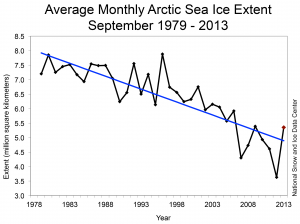
Monthly September ice extent for 1979 to 2013 shows a decline of 13.7% per decade. Figure: National Snow and Ice Data Center
The extent of sea ice in the northern hemisphere varies with the season. Normally it covers an area of 5-15 million km2, corresponding to 0.5-1.5 the area of Europe. The total volume of ice is calculated at 13 000 km3 in the summer and 16 500 km3 at the end of winter. Formation of sea ice in the winter is essentially counterbalanced by melting in the summer, aided by factors such as the East Greenland Current, which transports 2 000-3 000 km3 of drift ice out of the Arctic Ocean annually. The extent of the ice is smallest in September and largest in March.
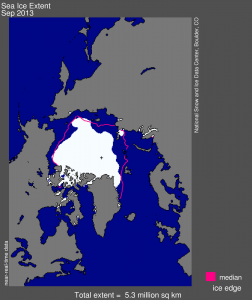
Arctic sea ice extent for September 2013 was 5.35 million square kilometers (2.07 million square miles). The magenta line shows the 1981 to 2010 median extent for that month. The black cross indicates the geographic North Pole. Figure: National Snow and Ice Data Center
It is impossible to give any precise figures on ice extent prior to 1979, but some descriptions of the ice extent can be found in historic records and old maps. Since 1978, sea ice has been monitored round the clock from satellites fitted with passive microwave instrumentation. Each image covers 25-50 km, making the resolution rather low. Changes in snow cover, water on top of the ice, and its salinity and temperature can also lead to misinterpretation of its extent.
Nonetheless, these long time series provide unique data, robust enough for analysis of long-term trends and deviations from ”normal”, and several different sets of observations can be compared and used analyses. Since the beginning of the 1990s, analyses are based on SAR data (synthetic aperture radar data), yielding ice charts with greater detail and more precision.
Sea ice thickness was previously measured by drilling holes at specific sites along the Arctic coast. After 1958, measurements using sonar have been taken sporadically from submarines, and as of the 1990s, also from permanent installations. Sea ice was measured from satellites fitted with radars starting in 1993, and with lasers starting in 2003. The Norwegian Polar Institute also monitors ice with the ”EM-bird”, an instrument that employs electromagnetic induction to calculate ice thickness. Other ice measurement methods include buoys in the ice that calculate mass balance over large geographic areas, and sonars mounted on arrays of buoys that measure ice mass balance continuously over long spans of time. This information helps validate results obtained using satellite data and models of sea ice.
The Arctic
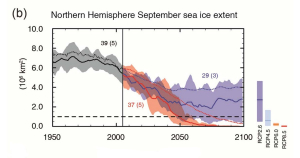
Photo: IPPC 2013
In recent years, the sea ice in the Arctic has decreased significantly in both extent and thickness. Over the period 2001-2011, the average sea ice extent in September was 5.49 million km2, which is 22% less than the 7.04 million km2 average for the period 1979-2000. The ice extent in September has decreased considerably in recent years, reaching a record low extent of 3.41 million km2 in the middle of September 2012. The trend over the past decade (2001-2011) is a loss of 191 000 km2 per year (which corresponds to a loss of 27% per decade relative to the average extent for 1979-2000. The extent of the ice has not declined as much in the winter season, but even there we see a reduction. The March average for the period 2001-2011 was 15.04 million km2, or 4.5% below the 1979-2000 average of 15.75 million km2.
When the ice reached its maximum extent in the middle of March 2013 it covered 15.13 million km2: that was the sixth lowest reading since satellite measurements began. The smallest maximum ever was noted in March 2011.
The IPCC summary of available knowledge indicates that the total extent of sea ice decreased by 3.5-4.1% per decade between 1979 and 2012, while the amount of sea ice that has survived at least one summer decreased by 9.4-13.6% per decade. Changes in ice extent are almost certainly more rapid than previously, and the fastest changes of all are occurring in summer and autumn. There is documentation suggesting that the ice in the Arctic Ocean has become 1.3 to 2.3 metres thinner (on average) between 1980 and 2008. In some parts of the Arctic, this means that ice-free conditions last up to two months longer. These pan-Arctic trends are apparent also in waters near Norway, the Barentshavet og Framstredet (See MOSJ indicators: Sea ice extent in the Barents Sea and Fram Strait) and Thickness of sea ice in the Arctic Ocean measured in the Fram Strait)
. Changes in ice extent are almost certainly more rapid than previously, and the fastest changes of all are occurring in summer and autumn. There is documentation suggesting that the ice in the Arctic Ocean has become 1.3 to 2.3 metres thinner (on average) between 1980 and 2008. In some parts of the Arctic, this means that ice-free conditions last up to two months longer. These pan-Arctic trends are apparent also in waters near Norway, the MOSJ? show a distinct negative tendency in ice extent throughout the monitoring period, and reveal substantial variability in the thickness of ice passing through Fram Strait, although both the variability and the thickness have decreased in recent years.
Data from ice cores, tree rings and lake-bottom sediments show that there is less sea ice cover in the Arctic now than at any time over the past 1450 years.
At no time in the past 1450 years has there been a greater loss of sea ice than what we have observed since the beginning the 1990s. The study also shows that the ice reached its greatest extent in 1912, in the final phase of the “Little Ice Age”. The study’s reconstruction reveals no clear relationship between historic ice coverage and atmospheric temperature; rather it appears that sea ice extent is the result of complex interactions between atmospheric circulation and ocean currents – confirming what we see today.
Every year since 2007, the observed minimum sea ice extent has been considerably under the minimum predicted by climate models, on the order of two standard deviations below the average extent for 1979-2000. The models have thus been unable to predict this rapid melting. Every year after 2007, the minimum extent of sea ice has been lower than was ever observed before 2007. The low ice coverage has lasted through October, when ice normally starts to form and ice extent increases. In addition to the record low ice extent in summer, sea ice coverage hit a record low in January 2011. Hudson Bay did not freeze over until the middle of January – about a month later than usual. At that time, the Labrador Sea was still essentially ice-free. Low ice coverage in September is a consequence of little ice at the beginning of the summer season. The record low sea ice extent in September of 2012 was on the same order of magnitude as what the IPCC, in 2007, predicted would not be seen until 2070. SWIPA adjusted the projections to show this amount of ice in 2040. The climate models must still be improved so they can describe changes that have already been observed, and provide more accurate projections for the future. Currently available climate models show an ice-free Arctic Ocean in summer by the end of this century – probably even within the next 30 to 40 years.
Sea ice in the Arctic is currently dominated by relatively young ice; lots of first-year and less multiyear ice. Over the past few years, the oldest multiyear ice (older than 5 years) has been disappearing rapidly, particularly in the Canadian Arctic, and most of this oldest ice is now gone. The summers of 2008 and 2009 were less extreme than the summer of 2007 in terms of loss of ice, and relatively little ice was transported out of the Arctic Basin during the winters of 2009-2010 and 2010-2011. During these years, the amount of young multiyear ice (2-3 years old) increased. This shows how annual variations also influence ice conditions, in combination with the overall downward trend. The Arctic will probably become increasingly dominated by first-year ice. Multiyear ice will probably disappear quickly and in “surges” rather than gradually.
The waters of the Barents Sea and around Svalbard are characterised by seasonal formation of sea ice that melts away during the summer (seasonal sea ice). Landfast ice forms in the fjords. In northeastern Svalbard, some ice can survive an entire summer, becoming first-year ice and ultimately multiyear, provided it survives several summers. Some multiyear ice can drift into the Barents Sea. There has been little ice around Jan Mayen in recent years, but drift ice is occasionally present. Ice conditions in this area vary substantially from year to year, but the overall trend throughout the measurement period is negative. In Fram Strait, sea ice consists mainly of drift ice from the Arctic Ocean moving southward with the East Greenland Current along the east coast of Greenland. Some of this drift ice is old multiyear ice that can be several metres thick and quite hard owing to packing and formation of pressure ridges. Ice drift velocity in the Arctic Ocean has increased, mainly due to lower ice density and thinner ice. Monitoring data presented in MOSJ? indicate a huge loss of multiyear ice through Fram Strait since 2005, after a relatively stable period in the 1990s.
Sea ice melting in the Arctic is caused by a combination of global warming and positive feedback mechanisms that speed up the melt rate as the ice gets thinner and the ice cover shrinks. These effects come in addition to the natural variations in sea ice cover on different time scales.
Antarctica
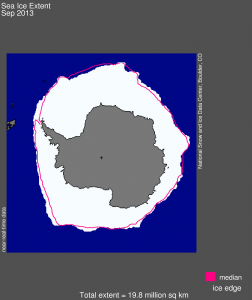
Antarctic sea ice extent for September 2013 was 19.77 million square kilometers (7.63 million square miles). The magenta line shows the 1981 to 2010 median extent for that month. The black cross indicates the geographic South Pole. Figure: National Snow and Ice Data Center
The extent of Antarctic sea ice is stable or increasing slightly, albeit with large regional differences. The ice extent in Antarctica reached a record high in 2013, when it was greater than at any time for which measurements from satellites are available. Satellite data from Antarctica show that the average ice extent has increased slightly in the area as a whole (ranging from 1.2 to 1.8% per decade between 1979 and 2012), but that the regional differences are large. Around the Antarctic Peninsula, the sea ice cover is shrinking. In the Bellingshausen Sea, the ice cover has retreated, with about 5.3% less ice cover per decade in recent years, an effect that correlates closely with rising temperature over the Antarctic Peninsula. West of the Antarctic Peninsula, the ice season is now almost 90 days shorter, and multiyear ice has disappeared. These changes are accelerating. The trends in sea ice in the south can be linked to ice movement patterns; wind-driven changes in the advection of ice appear to be the most important factor. It has also been suggested that fresh water from the melting ice sheet plays a role.
Future scenarios
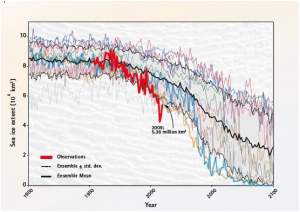 Most climate models predict an essentially ice-free Arctic Ocean within this century, some models as soon as 2040. The accuracy of the model predictions for sea ice is still not good enough, and the models have been unable to recreate the rapid disappearance of sea ice observed since 2005.
Most climate models predict an essentially ice-free Arctic Ocean within this century, some models as soon as 2040. The accuracy of the model predictions for sea ice is still not good enough, and the models have been unable to recreate the rapid disappearance of sea ice observed since 2005.
Available knowledge indicates that is it is reasonable to assume that sea ice around Antarctica will gradually decrease in extent and thickness.
Processes
The amount and the properties of snow on top of sea ice, the occurrence of soot and meltwater ponds on the ice are all factors that affect albedo?. Much of the research done today focuses on quantifying how these factors contribute to melting in the Arctic. The role of clouds in global warming is also a focus of research interest, as are attempts to understand how a reduction of sea ice in the Arctic will affect cloud formation. These research results will make climate models more robust and accurate, which is crucial for projecting future developments in sea ice.
Consequences
Less ice and thinner ice in the Arctic will have many consequences, some of which involve thermodynamic feedback to the climate system. Most of the feedback loops in the ocean–ice–climate system are positive; in other words, they enhance melting and warming. The global climate system is controlled by the energy balance in the ocean and atmosphere, and sea ice plays a crucial role in the climate.
Global ocean and atmospheric circulation is driven by forces that strive to eliminate temperature differences between the poles and the equator, and heat exchange between ocean and atmosphere is an important factor. Since sea ice floats, it “puts a lid” on the ocean, creating a barrier between the atmosphere and ocean. In this way, sea ice strongly influences heat exchange. In winter, the air in polar regions is extremely cold, while the sea is considerably warmer. Sea ice serves as an insulating layer between the ocean and the atmosphere, preventing warmth in the ocean from reaching the atmosphere. About half of the heat exchange in the Arctic Ocean occurs through openings in the ice: leads or polynyaer?.
When sea ice thins and ice coverage decreases, more heat from the ocean penetrates through the insulating layer and heats the atmosphere. The ice melts both from above, in contact with warmer air, and from below, in contact with warmer water.
In, on, and under the sea ice, there are entire ecosystems that depend on ice. These ecosystems, and all the ice-associated species that are a part of them, will be affected to a greater or lesser degree now that the Arctic sea ice is diminishing. Some endemic arctic species will probably become extinct if the ice continues to shrink. Species from more southerly latitudes will extend their range northward, and may compete with and displace arctic species.
At the same time, an ice-free ocean opens up previously ice-bound areas for shipping and exploitation of resources. The international community must soon make decisions concerning the opportunities and risks these changes entail.
